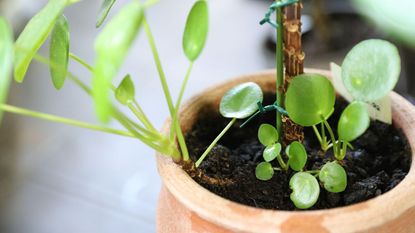How to propagate Chinese money plants
Discover how to propagate Chinese money plant like an expert


Looking to grow your plant collection? Learning how to propagate Chinese money plants is easy to do and hugely satisfying. Get the basics right and you will soon be revelling in your own leafy indoor jungle and winning over friends and family with a plethora of new plants.
These leafy beauties with their deep green, rounded leaves are traditionally said to bring the household good luck and fortune. Originating from South China, their large – almost circular leaves – were thought to resemble coins which led to the plant being highly revered.
Today they are much adored for their sculptural good looks and easy-going nature – growing and caring for Chinese money plants is incredibly simple. Reaching up to 12inches (30cm) tall they have real impact displayed on their own or as an eye-catching contrast when mixed with other indoor plants. Happy in a bright but not too sunny spot, they are the must-have plant for every style conscious home.
How to propagate Chinese money plant?
Often referred to as the Friendship Plant or Pass-it-on-plant, these beautiful indoor plants with their distinctive, rounded leaves, regularly produce new offshoots. Emerging around the base of the main stem they can either be left to form a fuller, single plant or removed and potted up to form separate plants.
How to separate off Chinese money plantlets
Producing many young plants each year, Chinese money plants can be easily divided.
Forming as smaller versions of the parent plant, Chinese money plantlets appear around the base of the plant and can get growing surprisingly quickly. To pot them up on their own – either to add to your collection or give away to friends – simply remove the whole plant from the pot, and carefully knock away some of the outer soil. This will loosen the plant’s root structure.
Holding the stem of the young offshoot, gently ease away from the main plant. The young plant will have already have grown it’s own root system, so handle carefully and immediately pop into a separate smaller pot filled with specialist indoor potting compost.
Water lightly, making sure not to waterlog the soil, as this will cause the roots to rot.
How to propagate Chinese money plant from stem cuttings
It is still possible to grow new plants from an established Chinese money plant even if there are no baby plants around the base. Known as stem cuttings, these are pretty easy to do, and just need a little time and patience to grow.
Hannah McWhorter at Lively Root explains how to go about it, ‘In early spring, take a pilea cutting, use a sharp knife to cut off pinkish red baby offshoots from the main stem. Remove at least an inch of stalk under the soil leading to the main stem. Be careful not to catch the knife of the healthy leaves on the mother plant.’
Carefully slide the fresh cutting into a pot of indoor plant compost. Specially formulated with grit to aid drainage and enriched with nutrients, it will provide everything the young plant needs for up to two or three months of growth. Gently firm around the base of the plant and lightly water, before placing in a warm, light spot out of direct sunlight, which could scorch the leaves.
Can I grow a new Chinese money plant from a leaf?
It is absolutely possible to grow a new Chinese money plant from a leaf, but there are some key points to bear in mind. Raffaele Di Lallo for Ohio Tropics explains, ‘All you have to do is cut off a single leaf, but you need to include a small portion of the stem or trunk that it’s attached to. Be careful when you cut into the trunk, don’t go too deep where you’ll weaken the trunk or potentially snap it off. Once you have your single leaf cuttings, simply place them in water.’
After two months, changing the water at least once a week, roots should form, and the new young plants can be potted up in indoor plant compost and grown on.
Ensuring your plant is healthy first, checking problems such as why your Chinese money plant's leaves are curling, will guarantee better results for propagation.
Sign up to the Homes & Gardens newsletter
Design expertise in your inbox – from inspiring decorating ideas and beautiful celebrity homes to practical gardening advice and shopping round-ups.

Jill Morgan has spent the last 20 years writing for Interior and Gardening magazines both in print and online. Titles she has been lucky enough to work on include House Beautiful, The English
Home, Ideal Home, Modern Gardens and Gardeningetc.com. Although much of her career has involved commissioning and writing about reader homes and home improvement projects, her
everlasting passion is for gardens and outdoor living, which is what she writes about for Homes & Gardens.
-
 Sonja Morgan's Upper East Side townhouse 'exudes a refined European ambiance' – and it's going to auction
Sonja Morgan's Upper East Side townhouse 'exudes a refined European ambiance' – and it's going to auctionThe home, which served as the backdrop to The Real Housewives of New York City, will have a new owner later this month
By Megan Slack Published
-
 5 colors to never pair with gray according to designers – to ensure you make the most of this cool-toned neutral
5 colors to never pair with gray according to designers – to ensure you make the most of this cool-toned neutralWhat colors should you never pair with gray? According to interior designers and color experts, these five colors should be avoided next to this cool-toned neutral
By Emily Moorman Published